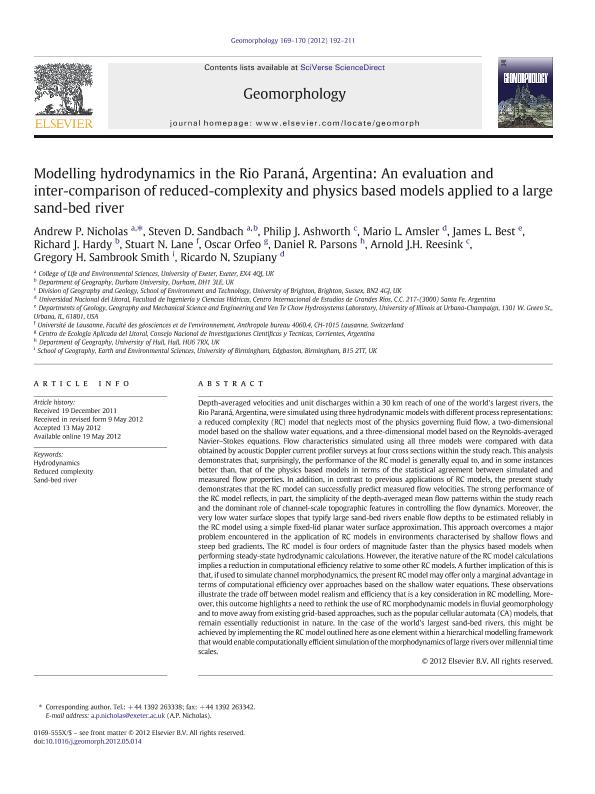Mostrar el registro sencillo del ítem
dc.contributor.author
Nicholas, Andrew P.

dc.contributor.author
Sandbach, Steven D.

dc.contributor.author
Ashworth, Philip J.

dc.contributor.author
Amsler, Mario Luis

dc.contributor.author
Best, James L.

dc.contributor.author
Hardy, Richard J.

dc.contributor.author
Lane, Stuart N.

dc.contributor.author
Orfeo, Oscar

dc.contributor.author
Parsons, Daniel R.

dc.contributor.author
Reesink, Arnold J.

dc.contributor.author
Sambrook Smith, Gregory H.

dc.contributor.author
Szupiany, Ricardo Nicolas

dc.date.available
2018-10-10T19:42:14Z
dc.date.issued
2012-10
dc.identifier.citation
Nicholas, Andrew P.; Sandbach, Steven D.; Ashworth, Philip J.; Amsler, Mario Luis; Best, James L.; et al.; Modelling hydrodynamics in the Rio Paraná, Argentina: An evaluation and inter-comparison of reduced-complexity and physics based models applied to a large sand-bed river; Elsevier Science; Geomorphology; 169-170; 10-2012; 192-211
dc.identifier.issn
0169-555X
dc.identifier.uri
http://hdl.handle.net/11336/62120
dc.description.abstract
Depth-averaged velocities and unit discharges within a 30. km reach of one of the world's largest rivers, the Rio Paraná, Argentina, were simulated using three hydrodynamic models with different process representations: a reduced complexity (RC) model that neglects most of the physics governing fluid flow, a two-dimensional model based on the shallow water equations, and a three-dimensional model based on the Reynolds-averaged Navier-Stokes equations. Flow characteristics simulated using all three models were compared with data obtained by acoustic Doppler current profiler surveys at four cross sections within the study reach. This analysis demonstrates that, surprisingly, the performance of the RC model is generally equal to, and in some instances better than, that of the physics based models in terms of the statistical agreement between simulated and measured flow properties. In addition, in contrast to previous applications of RC models, the present study demonstrates that the RC model can successfully predict measured flow velocities. The strong performance of the RC model reflects, in part, the simplicity of the depth-averaged mean flow patterns within the study reach and the dominant role of channel-scale topographic features in controlling the flow dynamics. Moreover, the very low water surface slopes that typify large sand-bed rivers enable flow depths to be estimated reliably in the RC model using a simple fixed-lid planar water surface approximation. This approach overcomes a major problem encountered in the application of RC models in environments characterised by shallow flows and steep bed gradients. The RC model is four orders of magnitude faster than the physics based models when performing steady-state hydrodynamic calculations. However, the iterative nature of the RC model calculations implies a reduction in computational efficiency relative to some other RC models. A further implication of this is that, if used to simulate channel morphodynamics, the present RC model may offer only a marginal advantage in terms of computational efficiency over approaches based on the shallow water equations. These observations illustrate the trade off between model realism and efficiency that is a key consideration in RC modelling. Moreover, this outcome highlights a need to rethink the use of RC morphodynamic models in fluvial geomorphology and to move away from existing grid-based approaches, such as the popular cellular automata (CA) models, that remain essentially reductionist in nature. In the case of the world's largest sand-bed rivers, this might be achieved by implementing the RC model outlined here as one element within a hierarchical modelling framework that would enable computationally efficient simulation of the morphodynamics of large rivers over millennial time scales. © 2012 Elsevier B.V.
dc.format
application/pdf
dc.language.iso
eng
dc.publisher
Elsevier Science

dc.rights
info:eu-repo/semantics/openAccess
dc.rights.uri
https://creativecommons.org/licenses/by-nc-sa/2.5/ar/
dc.subject
Hydrodynamics
dc.subject
Reduced Complexity
dc.subject
Sand-Bed River
dc.subject.classification
Geociencias multidisciplinaria

dc.subject.classification
Ciencias de la Tierra y relacionadas con el Medio Ambiente

dc.subject.classification
CIENCIAS NATURALES Y EXACTAS

dc.title
Modelling hydrodynamics in the Rio Paraná, Argentina: An evaluation and inter-comparison of reduced-complexity and physics based models applied to a large sand-bed river
dc.type
info:eu-repo/semantics/article
dc.type
info:ar-repo/semantics/artículo
dc.type
info:eu-repo/semantics/publishedVersion
dc.date.updated
2018-09-18T16:23:40Z
dc.journal.volume
169-170
dc.journal.pagination
192-211
dc.journal.pais
Países Bajos

dc.journal.ciudad
Amsterdam
dc.description.fil
Fil: Nicholas, Andrew P.. University of Exeter; Reino Unido
dc.description.fil
Fil: Sandbach, Steven D.. University of Exeter; Reino Unido. University Of Durham; Reino Unido
dc.description.fil
Fil: Ashworth, Philip J.. University of Brighton; Reino Unido
dc.description.fil
Fil: Amsler, Mario Luis. Universidad Nacional del Litoral. Facultad de Ingeniería y Ciencias Hídricas. Departamento de Hidráulica; Argentina. Consejo Nacional de Investigaciones Científicas y Técnicas. Centro Científico Tecnológico Conicet - Santa Fe. Instituto Nacional de Limnología. Universidad Nacional del Litoral. Instituto Nacional de Limnología; Argentina
dc.description.fil
Fil: Best, James L.. University of Illinois at Urbana; Estados Unidos
dc.description.fil
Fil: Hardy, Richard J.. University Of Durham; Reino Unido
dc.description.fil
Fil: Lane, Stuart N.. Universite de Lausanne; Suiza
dc.description.fil
Fil: Orfeo, Oscar. Consejo Nacional de Investigaciones Científicas y Técnicas. Centro Científico Tecnológico Conicet - Nordeste. Centro de Ecología Aplicada del Litoral. Universidad Nacional del Nordeste. Centro de Ecología Aplicada del Litoral; Argentina
dc.description.fil
Fil: Parsons, Daniel R.. University of Hull; Reino Unido
dc.description.fil
Fil: Reesink, Arnold J.. University of Brighton; Reino Unido
dc.description.fil
Fil: Sambrook Smith, Gregory H.. University of Birmingham; Reino Unido
dc.description.fil
Fil: Szupiany, Ricardo Nicolas. Universidad Nacional del Litoral. Facultad de Ingeniería y Ciencias Hídricas. Departamento de Hidráulica; Argentina. Consejo Nacional de Investigaciones Científicas y Técnicas; Argentina
dc.journal.title
Geomorphology

dc.relation.alternativeid
info:eu-repo/semantics/altIdentifier/doi/https://doi.org/10.1016/j.geomorph.2012.05.014
dc.relation.alternativeid
info:eu-repo/semantics/altIdentifier/url/https://www.sciencedirect.com/science/article/pii/S0169555X12002413
Archivos asociados
